

Biomimicry examples, tips, & resources - SYNAPSE by Biomimicry 3.8 - 10 classic biomimicry examples. Science Channel - 4D-Printed Plants Move Like The Real Thing. 5 Nature-Inspired Innovations. The shifting hues of squid skin, the stickiness of gecko toes, the self-cleansing of lotus leaves.
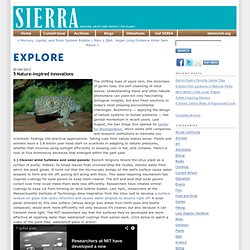
Understanding these and other natural phenomena can yield not only fascinating biological insights, but also fresh solutions to today’s most pressing environmental challenges. Biomimicry — applying the design of natural systems to human problems — has gained momentum in recent years. Last August, the San Diego Zoo opened its Center for Bioinspiration, which works with companies and research institutions to translate zoo scientists’ findings into practical applications.
Taking cues from nature makes sense. Plants and animals have a 3.8 billion year head start on scientists in adapting to natural pressures, whether that involves using sunlight efficiently or keeping cool in hot, arid climates. 1.) 2.) 3.) A firefly's light results from a chemical reaction that occurs in the cuticle, a part of the insect's protective outer covering. 4.) 5.) Structuring Biomimicry, Improving Building’s Resiliency. The same way Einstein assumes the speed of light to be a constant of reference for his Theory of Relativity, the philosophy of biomimicry assumes Nature as a constant of reference to a performance-based beauty for design.
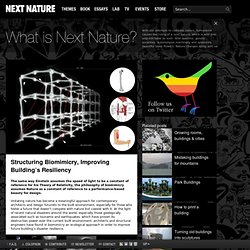
Imitating nature has become a meaningful approach for contemporary architects and design futurists to the built environment, especially for those who foster a future that doesn’t compete with nature but coexist with it. At the light of recent natural disasters around the world, especially those geologically associated such as tsunamis and earthquakes, which have proven its destruction power over the current built environment; architects and structural engineers have found in biomimicry an ecological approach in order to improve future building’s disaster resilience.
Present built structures are unresponsive to the Earth dynamics and aren’t completely adapted to the ecosystem flows of forces. Darwinians Try to Usurp Biomimetics Popularity. As we've reported often before, biomimetics is hot.

Supported by university departments and peer-reviewed journals, scientists and engineers are racing to copy nature's designs. It's all based on "design thinking," from concept to application, and thus an excellent illustration of the fruitfulness of intelligent design in science, even if that fact goes largely unacknowledged. The bioengineer is first inspired by a natural design, then seeks to understand it, then tries to mimic it. Examples abound from all over the living world: Sharks: A startup company called Sharklet Technologies has designed a new material that mimics shark skin's ability to resist attachment by microbes, algae, and barnacles. First man-made biological leaf will generate oxygen. If there was a blue-ocean-strategy kind of way to fight climate change and the bunch of related problems, the creation of an artificial leaf capable of performing photosynthesis on its own would be it.
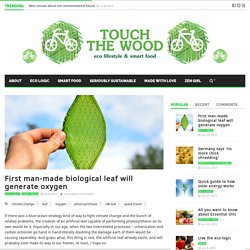
Especially in our age, when the two interrelated processes – urbanization and carbon emission go hand in hand literally doubling the damage each of them would be causing separately. And guess what, this thing is real, the artificial leaf already exists, and will probably soon make its way to our homes. At least, I hope so. The author of this ingenious sustainable solution for the indoor and outdoor urban ecohomes is Julian Melchiorri, an internationally known innovative designer of British and Italian origin. Taking interest in sustainable technology and understanding the importance of fostering zero-growth mindset in households, he combined the creative idea with recent sustainable discoveries in biology.
How does photosynthesis work? Research process When can we have it? P.S. Virtual Design Lab: Four nature-inspired projects poised to make the world a better place. From developing an undergrad class to inspire biomimicry in business to creating an affordable prosthetic hand design that can be made from a 3D printer, we’re proud of the work our students are doing to bring biomimicry-based solutions to the world.
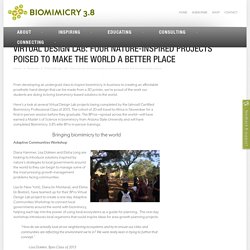
Here’s a look at several Virtual Design Lab projects being completed by the (almost) Certified Biomimicry Professional Class of 2015. The cohort of 20 will travel to Africa in November for a final in-person session before they graduate. The BPros—spread across the world—will have earned a Master’s of Science in biomimicry from Arizona State University and will have completed Biomimicry 3.8′s elite BPro in-person trainings. Adaptive Communities Workshop Diana Hammer, Lisa Dokken and Elisha Long are looking to introduce solutions inspired by nature’s strategies to local governments around the world to they can begin to manage some of the most pressing growth management problems facing communities. 2015 in Review: Animals and Biomimicry. Sometimes the truth is stranger than fiction, which is an idea that certainly carries over to the mysteries of nature (watch enough Discovery Channel and you'll be well aware of this fact).
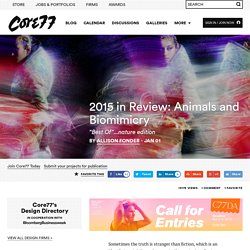
Sometimes these amazing facts, either abstractly or directly, are helpful for designers—hence, biomimicry. [Editor's Note: See the co-director of the Biomimicry Instiute Prasad Boradkar's argument for "Design for All Life"] How can these interesting elements of nature be borrowed for better, more ergonomic, or more innovative products and designs? How much will nature's inherent design aspects affect our manmade designs in the future? In this Year in Review, we take a focus on the natural world: whether it's purely a fascinating phenomenon within nature or a product inspired by the natural world around us, here are all our noteworthy articles from the year in animals.
Ants Building Rafts and Bridges to Escape Flooding Enter a caption (optional) Sputniko! Wounded Turtle Gets Titanium 3D Printed Jaw. Biomimicry: Design Inspired by Nature. How Would Nature Design A Company? BioInspired Business Book by Dr. Tamsin Woolley-Barker. Biology Inspires Idea for Improving Lithium Ion Batteries. Teeth and bones, snail shells and bird eggs are formed via a process called biomineralization.
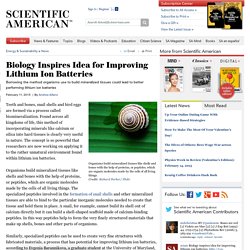
Found across all kingdoms of life, this method of incorporating minerals like calcium or silica into hard tissues is clearly very useful in nature. The concept is so powerful that researchers are now working on applying it to the rather unnatural environment found within lithium ion batteries. Organisms build mineralized tissues like shells and bones with the help of proteins, or peptides, which are organic molecules made by the cells of all living things. The specialized peptides involved in the formation of snail shells and other mineralized tissues are able to bind to the particular inorganic molecules needed to create that tissue and hold them in place.
Biomimicry NYC » 101 Ways Biomimicry Will Save the World. On Monday, April 13th, the BiomimicryNYC network helped Terrapin Bright Green launch their most recent white paper, “Tapping into Nature: The Future of Energy, Innovation and Business“.
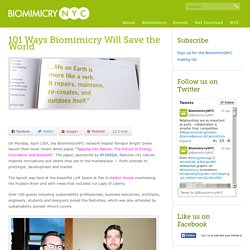
The paper, sponsored by NYSERDA, features 101 nature-inspired innovations and where they are in the marketplace — from concept to prototype, development and market. The launch was held at the beautiful Loft Space at Pier A Harbor House overlooking the Hudson River and with views that included our Lady of Liberty. Over 100 guests including sustainability professionals, business executives, architects, engineers, students and designers joined the festivities, which was also attended by sustainability pioneer Amory Lovins.
7 examples of biomimicry: Copying Mother Nature. Inhabitat - Green Design, Innovation, Architecture, Green Building. 14 Smart Inventions Inspired by Nature: Biomimicry: Nature as R&D Lab. Companies seeking breakthrough products tend to ignore the greatest invention machine in the universe: life’s more than three-billion-year history of evolution by natural selection.
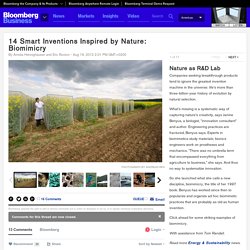
What’s missing is a systematic way of capturing nature’s creativity, says Janine Benyus, a biologist, "innovation consultant" and author. Engineering practices are fractured, Benyus says. Experts in biomimetics study materials; bionics engineers work on prostheses and mechanics. "There was no umbrella term that encompassed everything from agriculture to business," she says. Biomimicry in Action: 13 Technologies Inspired by Nature. The 15 Coolest Cases of Biomimicry. Cocoon_FS: Pohl Architects Unveils Prefab Plankton-Inspired Pod Building in Germany Prefab Plankton Building Cocoon_FS by Pohl Architects – Inhabitat - Green Design Will Save the World. Planktontech Home. Mitchell Joachim: Don't build your home, grow it!